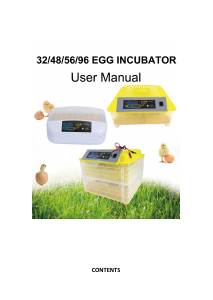© by WilTec Wildanger Technik GmbH Item 51185, 51186 Page 8
http://www.WilTec.de
http://www.aoyue.eu 03 2022-1
http://www.teichtip.de
• Check the individual values with the help of an additional thermometer and hygrometer. If nec-
essary, calibrate the values. Test how you can keep the desired air humidity at the right level/
how much water is required to stay in the desired range.
• If the incubator works without a problem, and you are accustomed with the functions, unplug
the incubator and clean it from the inside and the outside with a suitable disinfectant.
Adding the eggs
• As soon as the incubator has been cleaned, you can place water into the grooves. Please note,
that the air humidity should be noticeably lower at the beginning of the breeding process than
towards the end (at least for most bird types). Therefore, only fill a little bit of water into the
grooves at the beginning. The incubator has a small opening on the side (see picture 3), through
which water can be filled when needed (too low air humidity). Thus, the lid does not must be
opened during the breeding process.
Note: Please note the individual requirements of every type of animal. Do not place too much
water into the incubator as this can lead to bad hatching results. Ideally, you have already found
out how much water is required at the beginning.
Note: If the humidity is too low, even though the two grooves are filed with plenty of water, a
bowl can be added to the incubator. Please be careful not to make the eggs or the inlay wet.
Do not keep the incubator open for too long, when placing the bowl, as this can have a negative
impact on the hatching result.
Important: Choose the shape and design of the water bowls, making sure they do not pose a
fatal risk to hatched chicks and reptiles.
After adjusting the according parameters of the incubator, the eggs can be placed into the incu-
bator with the tip downward. Set the number of days to 0.
• Regularly check the temperature and humidity on the
control panel of the incubator and, if necessary, alter the
parameters. Pay attention to the water level in the
grooves of the incubator, there should always be enough
water.
Important: There must be no water on the egg inlay! This
can otherwise have a negative impact on the hatching re-
sults!
• Towards the end of the hatching process, the poultry
eggs must not be turned any longer. The automatic turn-
ing mechanism needs to be switched off then. Therefore,
the electricity supply neds to be disconnected between
the turning motor and the turning insert, by disconnecting
the cables. The according cables can be found in the turn-
ing insert.
Fig. 3: Opening for water refill
• It is also possible to remove the turning mechanism entirely. Open the incubator, disconnect
both cables of the turning motor from one another and lift the turning mechanism out of the
incubator. Then place all eggs carefully back onto the insert in the incubator. Spray the eggs
with warm water and carefully, yet fast place the eggs, allowing for the humid and warm climate
to be kept sustained.
Important: Please note that the incubator should not be opened towards the end of the breeding
process with more sensitive species. Thus, ensure that the humidity is high enough, as soon as
the eggs are placed still and the turning mechanism is switched off. During the hatching process,
the lid should remain closed. Water can be refilled via the hole, to avoid the eggshells from
drying out.
• During the hatching process, the lid should remain closed. Water can be refilled to protect the
eggshells from drying out.
• If the chicks have hatched, you need to ensure they cannot drown, whereas chicks still breeding
need to hatch.












Praat mee over dit product
Laat hier weten wat jij vindt van de Wiltec 51185 Broedmachine. Als je een vraag hebt, lees dan eerst zorgvuldig de handleiding door. Een handleiding aanvragen kan via ons contactformulier.
beantwoord | Ik vind dit nuttig (0)